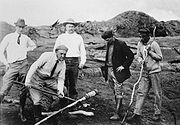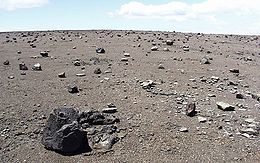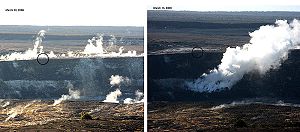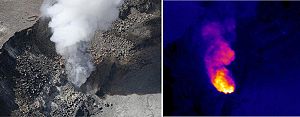
Halemaumau Crater
Encyclopedia


Pit crater
A pit crater is a depression formed by a sinking of the ground surface lying above a void or empty chamber, rather than by the eruption of a volcano or lava vent. It is often found in chains or troughs. Several craters may merge into a linear alignment...
located within the much larger summit caldera
Caldera
A caldera is a cauldron-like volcanic feature usually formed by the collapse of land following a volcanic eruption, such as the one at Yellowstone National Park in the US. They are sometimes confused with volcanic craters...
of Kīlauea
Kilauea
Kīlauea is a volcano in the Hawaiian Islands, and one of five shield volcanoes that together form the island of Hawaii. Kīlauea means "spewing" or "much spreading" in the Hawaiian language, referring to its frequent outpouring of lava. The Puu Ōō cone has been continuously erupting in the eastern...
in Hawaii Volcanoes National Park
Hawaii Volcanoes National Park
Hawaii Volcanoes National Park, established in 1916, is a United States National Park located in the U.S. State of Hawaii on the island of Hawaii. It encompasses two active volcanoes: Kīlauea, one of the world's most active volcanoes, and Mauna Loa, the world's most massive volcano...
. The roughly circular crater floor is 770 metres (2,526.2 ft) x 900 metres (2,952.8 ft) and is 83 metres (272.3 ft) below the floor of Kīlauea caldera, located at coordinates 19°24′36"N 155°17′11"W. Halemaumau is home to Pele, Goddess of Hawaiian Volcanoes, according to the traditions of Hawaiian mythology
Hawaiian mythology
Hawaiian mythology refers to the legends, historical tales and sayings of the ancient Hawaiian people. It is considered a variant of a more general Polynesian mythology, developing its own unique character for several centuries before about 1800. It is associated with the Hawaiian religion...
. According to the Hawaii Volcano Observatory the crater is currently active, with lava in an open vent fluctuating from 70 to 150 meters below the crater floor.
Early history
Early eruptions were only recorded by oral history. One large one in 1790 killed several people, and left footprints in hardened ash1790 Footprints
The 1790 Footprints refer to a set of footprints found near the Kīlauea volcano in present-day Hawaii Volcanoes National Park on the island of Hawaii...
of some ancient Hawaii
Ancient Hawaii
Ancient Hawaii refers to the period of Hawaiian human history preceding the unification of the Kingdom of Hawaii by Kamehameha the Great in 1810. After being first settled by Polynesian long-distance navigators sometime between AD 300–800, a unique culture developed. Diversified agroforestry and...
ans killed by pyroclastic flow
Pyroclastic flow
A pyroclastic flow is a fast-moving current of superheated gas and rock , which reaches speeds moving away from a volcano of up to 700 km/h . The flows normally hug the ground and travel downhill, or spread laterally under gravity...
s.
William Ellis, an English missionary and amateur ethnographer and geologist, published the first description of Halemaumau as it appeared in 1823.
In 1866 Mark Twain
Mark Twain
Samuel Langhorne Clemens , better known by his pen name Mark Twain, was an American author and humorist...
, an American humorist, satirist, lecturer and writer hiked to the Caldera floor.
He wrote the following account of the lake of molten lava which he found there:

Titus Coan
Titus Coan was an early American Christian Missionary to the Hawaiian Islands.-Early life and family:Titus Coan was born on February 1, 1801 in Killingworth, Connecticut, the son of Gaylord Coan and Tamza Nettleton. In June, 1831, he entered the Auburn Theological Seminary in Auburn, New York, and...
, observed and wrote about eruptions in the 19th century.
Geologist Thomas Jaggar
Thomas Jaggar
Thomas Augustus Jaggar, Jr. was an American volcanologist. He founded the Hawaiian Volcano Observatory and directed it from 1912 to 1940.-Biography:...
opened an observatory in 1912, and the area became Hawaii Volcanoes National Park
Hawaii Volcanoes National Park
Hawaii Volcanoes National Park, established in 1916, is a United States National Park located in the U.S. State of Hawaii on the island of Hawaii. It encompasses two active volcanoes: Kīlauea, one of the world's most active volcanoes, and Mauna Loa, the world's most massive volcano...
in 1916.

2008-2011 eruption episodes
Episodes are being listed in order of current activity for ease of reading and editing. As of late 2011, according to the Hawaiian Volcano ObservatoryHawaiian Volcano Observatory
The Hawaiian Volcano Observatory is a volcano observatory located at Uwekahuna Bluff on the rim of Kīlauea Caldera on the Island of Hawaii. The observatory monitors four active Hawaiian volcanoes: Kīlauea, Mauna Loa, Hualālai, and Haleakalā...
, the crater's vent is in an active state and has been "mostly active" since March, 2008.
- Other than the described events, no erupting or fountaining of lava has occurred in the crater, unlike the concurrent activity on the Eastern Rift Zone around Puu Ōō.
- The crater's webcams show the fume of the outgassing vent, and sometimes the nighttime glow of lava as seen from the Observatory http://volcanoes.usgs.gov/hvo/cams/KIcam/ and a lake of molten lava as seen from the crater rim, looking down into the vent http://volcanoes.usgs.gov/hvo/cams/HMcam/.
- The Halemaumau Overlook is closed, as are hiking trails that lead to the crater. Crater Rim Drive is closed between the Observatory and Chain of Craters RoadChain of Craters RoadChain of Craters Road is a 23 mile winding paved road through the East Rift and coastal area of the Hawaii Volcanoes National Park on the island of Hawaii, in the state of Hawaii, United States. The original road, built in 1928, connected Crater Rim Drive to Makaopuhi Crater...
because of sulfur dioxide gas emissions. Visitors may view the crater from the relatively safe locations of the Hawaiian Volcano Observatory and Volcano HouseVolcano HouseVolcano House is the name of a series of historic hotels built at the edge of the Kīlauea volcano, within the grounds of Hawai'i Volcanoes National Park on the Island of Hawai'i. The original 1877 building is listed on the National Register of Historic Places and now houses the Volcano Art Center...
. - Readers and visitors are encouraged to refer to the United States Geological SurveyUnited States Geological SurveyThe United States Geological Survey is a scientific agency of the United States government. The scientists of the USGS study the landscape of the United States, its natural resources, and the natural hazards that threaten it. The organization has four major science disciplines, concerning biology,...
's Hawaiian Volcano ObservatoryHawaiian Volcano ObservatoryThe Hawaiian Volcano Observatory is a volcano observatory located at Uwekahuna Bluff on the rim of Kīlauea Caldera on the Island of Hawaii. The observatory monitors four active Hawaiian volcanoes: Kīlauea, Mauna Loa, Hualālai, and Haleakalā...
website as they publish frequent eruption summaries, press releases, maps, and other data, as well as provides both real- and near real-time hazard data and panoramic Internet web camera views of events.
September 2008 eruption episode
A Hawaii Volcano Observatory news release and images dated September 5, 2008 confirmed the first recorded images of a lava lake 130 feet below the lip of the vent. The HVO had alluded to the presence of lava within the vent, including the sporadic ejecting of lava materials from the vent due to explosive episodes, but this gave officials the first opportunity to visually confirm that active lava was present. The report also noted that the lava cannot be seen from observation points around the crater.Since the vent's first appearance there have been six significant explosive events (the latest being September 2, 2008), changing the vent to its present shape of 65 meters or 215 feet across.
May–August 2008
Activity within the crater and vent continued to present scientists with work as the vent continued to eject ash and gases. It wasn't until August 1, 2008 that the crater was rocked with the 4th Explosive event and later on August 27, 2008 its 5th event.April 2008 eruption episode


Vog
Vog is a form of air pollution that results when sulfur dioxide and other gases and particles emitted by an erupting volcano react with oxygen and moisture in the presence of sunlight. The word is a portmanteau of the words "volcanic" and "smog"...
plume extended downwind from the crater. The evacuation lasted two days.
On April 16, 2008 the crater was rocked with its third significant explosive event, sending ash and debris throughout the area.
A second evacuation of the park and surrounding areas was ordered on April 23, 2008.
March 2008 eruption episode


Fumarole
A fumarole is an opening in a planet's crust, often in the neighborhood of volcanoes, which emits steam and gases such as carbon dioxide, sulfur dioxide, hydrochloric acid, and hydrogen sulfide. The steam is created when superheated water turns to steam as its pressure drops when it emerges from...
directly below the Crater Overlook; however the gas event was only a prelude when in the wee hours (02:58 am HST) of March 19, 2008 HVO personnel thought they were experiencing seismic events, but sunrise revealed a 20–30 metre (65–100 foot) diameter hole blown in the side where the vent once was; scattering debris and spatter across 0.3 square kilometres (74.1 acre) and damaging the Crater Overlook. Pieces as large as 20 millimetre (0.78740157480315 in) were found on Crater Rim Drive while 0.3 metre (0.984251968503937 ft) blocks hit the crater overlook area. This was the first explosive eruption of Halemaumau Crater since 1924, and the first lava eruption from the crater since 1982.
Sulfur dioxide
Sulfur dioxide
Sulfur dioxide is the chemical compound with the formula . It is released by volcanoes and in various industrial processes. Since coal and petroleum often contain sulfur compounds, their combustion generates sulfur dioxide unless the sulfur compounds are removed before burning the fuel...
gas emissions increased rapidly at the beginning of the episode. On March 13, HVO recorded a rate of 2,000 tons/day, the highest rate since measurements began in 1979. A concentration of over 40 ppm on Crater Rim Drive was measured, prompting alerts and other public safety measures. Halemaumau crater continued to intermittently emit high levels of volcanic gases
Vog
Vog is a form of air pollution that results when sulfur dioxide and other gases and particles emitted by an erupting volcano react with oxygen and moisture in the presence of sunlight. The word is a portmanteau of the words "volcanic" and "smog"...
, ash, spatter, Pele's Tears
Pele's tears
Pele’s tears is a geological term for small pieces of solidified lava drops formed when airborne particles of molten material fuse into tearlike drops of volcanic glass. Pele’s tears are jet black in color and are often found on one end of a strand of Pele's hair...
, and Pele's Hair
Pele's hair
Pele's hair is a geological term for volcanic glass threads or fibers formed when small particles of molten material are thrown into the air and spun out by the wind into long hair-like strands. The diameter of the strands is less than 0.5 mm, and they can be as long as 2 meters. Pele’s...
until the second episode.

